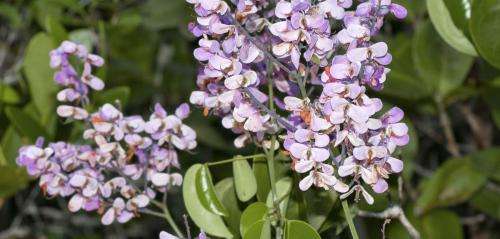Seeding plant diversity for future generations

(Phys.org) —The Millennium Seed Bank dries, freezes, stores and maintains seeds for future generations to enjoy and use. It aims to save seeds from all the wild plant species of the world and so far, since its founding in 2000, it has banked 14% of them. Scientists from the University of Oxford and the Royal Botanic Gardens, Kew, which manages the Millennium Seed Bank, have shown how by using advanced mathematics they can boost the overall diversity of the seed bank by targeting a 'hit list' of particular species. Their paper also includes maps showing where the species are located so they can be efficiently gathered. The findings are published in the journal Conservation Biology.
The research team constructed a new evolutionary tree of a major family of wild plant species, taking the distance between species as a proxy for plant trait diversity. This enabled the researchers to see how to capture overall plant diversity in the most efficient way. They calculate that by adding just 10 more carefully chosen species, the overall diversity of plant species in the seed bank would be boosted by 10%. Furthermore, the researchers say that by adding a particular 177 species to the bank, the seed vaults would contain almost the entire diversity of the family worldwide (95%).
More than 150 organisations in 80 countries are currently involved in collecting seeds from wild species. In their study, the team from Oxford and Kew suggest that if seed priority is determined only by whether they are endangered, of economic value, or endemic (otherwise known as the 3E approach), this would make the collection significantly less diverse than it could be. Happily, making sure a few carefully chosen species from the 'hit list' are collected will keep the diversity of the seed bank high into the future.
The researchers assessed the existing collection of the Millennium Seed Bank by focusing on the legume family. It is a big family – containing more than 19,000 plants including all the peas and beans, peanuts, clover and lupins – to see how it was represented in the seed bank. They found that the bank houses a 'robust' legume collection in terms of diversity. However, using the evolutionary tree, they found that as the seed bank collection grew in the future, if its collection strategy was determined by 3E priority species, something odd happened over time: the collection contained more and more close relatives and overall diversity diminished.
'Being a conservation priority plant isn't random: it depends upon your biology, ecology, and location,' said Professor Rich Grenyer of Oxford's School of Geography and the Environment, the coordinating author of the study. 'It depends on what you're like and where you are. And just like people, plant species tend to be most like their closest relatives, and to live quite near them too. So as the Millennium Seed Bank gets more and more of these conservation priority species, the overall diversity of the collection doesn't go up very much.
'The species that will come in are all really important, but they're also going to be more and more like each other. It's a trade-off: you can get more diversity at the cost of getting fewer conservation priority species.'
Tim Pearce, international coordinator at the Millennium Seed Bank and an author on the study, concluded: 'With the race against time to secure seed before it's gone forever, this insight into how best to capture maximum diversity gives us the opportunity to really focus on where in the world we need to target our seed-collecting programmes.'
Kate Griffiths, lead author of the paper and a postgraduate student at the University of Oxford's School of Geography and the Environment, explained: 'We don't know which plants and which plant traits will be most valuable in the future. Diversity gives us options. It was really surprising and very good news that diversity can be substantially boosted with relatively few additional species. It means that we can insure against diversity loss without making big changes. Hopefully we've shown that these kinds of win-win outcomes for conservation are out there and can be found for other groups of organisms and other conservation scenarios.'
John Dickie, head of botanical information at the Millennium Seed Bank, added: 'For a number of years we have been keen to know just how much phylogenetic diversity, the total outcome of millions of years of seed plant evolution, we have in the vault. Thanks to this study, we not only have a sound estimate of the effectiveness of our current collecting strategy in capturing legume phylogenetic diversity; but also the opportunity to efficiently improve our coverage and extend the method to other families.'
Journal information: Conservation Biology
Provided by Oxford University











.jpg)

.jpg)






